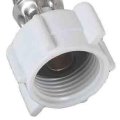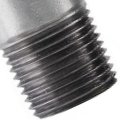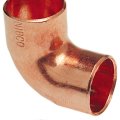Home Plumbing Connector Types
Fitting Examples
There are just a few examples of the huge diversity of plumbing fittings. In residential plumbing consider all of the different pipe materials available and all of the different ways they can be connected. Specific fixtures in the home have their own specific connection type, such as the water supply to a toilet. Finally, there are companies that make their own proprietary fittings and connectors. Proprietary types are not discussed and their use is discouraged.
The most typical connections between like building materials are made and some examples include: Copper pipes are typically connected with copper fittings that are smooth inside and soldered. You solder a fitting to a copper pipe. Steel (Galvanized) and Iron (Black) are sealed with Teflon (PTFE) tape or pipe thread compound since both types are threaded pipes. PEX connections are typically made with compression fittings, crimped on to create a water tight seal.
A wide variety of fittings are used in plumbing. Examples: brass, copper, CPVC, flexible, PVDF, cast iron, black, ABS, nylon, PVC and galvanized steel.
7/8" Ballcock Toilet Connector

Also called: 7/8 in. Ballcock Nut. Screws on to bottom of toilet tank. Slightly smaller than standard 1/2" pipe thread. Typically on a braid water connector that is 3/8" compression on the opposite end. A Toilet Ballcock Assembly is the entire upright part inside the toilet tank with with valve plunger on top and screw connector that sticks out though the hole in the bottom of the tank.
Common fittings:
- 3/8 Compression X 7/8 Ballcock 9"
- Plastic Toilet Swivel Adapter, 1/2" PEX x 7/8" BallCock
1/2" Pipe Thread

Also called: 1/2" NTP. National Pipe Thread Tapered Thread. This type of pipe thread is tapered so that the fit tightens as the pipe is twisted in. Common residential NTP pipe use is for water and natural gas.
3/4" Wrot Copper

Wrot copper solder pressure 90-degree elbow is used with residential copper pipe installations for water, air conditioning and refrigeration.
American Tapered Pipe Threads NTP
Two of the more popular thread forms used are the Dryseal American Standard Taper Pipe Thread (NPTF) and American Standard Straight Pipe Thread for Mechanical Joints (NPSM). Pipe thread sizes are described much as bolt sizes are. Pipe threads must make a mechanical joint and leakproof connection. To accomplish this, the threads become shallower the farther they are from the end of the pipe. The bottoms of the threads aren't on a cylinder, but a cone. The cone taper is 1/16" in 1", which is the same as 3/4" inch in 1'. American Standard Taper Pipe Threads (NPT) is defined by ANSI/ASME standard B1.20.1.
MIP stands for Male Iron Pipe, also known as MPT Male Pipe Thread. It is a term for pipe fittings. FIP stands for Female Iron Pipe, also known as FPT Female Pipe Thread, and is a term for pipe fittings that MIP fittings go into. The difference between FIP, MIP and Compression fittings is in the tapering of the thread.
Teflon tape or thread sealant compound is used on the pipe threads to help create a proper seal.
Some examples of pipe materials making use of MIP fittings include: galvanized steel, black iron, and sometimes thick copper. Galvanized steel most commonly for water, black iron most commonly for natural gas.
Galvanized Steel Pipe
Galvanized pipe is steel pipe covered with a protective coating of zinc which greatly reduces its tendency to corrode and extends its life expectancy. Public water supplies treat their water to make it essentially non-corrosive. However, plumbers will tell you that when they remove galvanized pipe, it is typically internally full of corrosion. Galvanized pipe is no longer commonly installed in residential water systems. Galvanized pipe was used extensively as water supply lines in new construction prior to the 1960's.
Calcium buildup and oxidation occur internally, causing a loss of water pressure as the opening inside the pipe decreases. A moderate level of calcium helps form a protective coating on the pipe, which may slow down corrosive effects. Even so, the pipe still corrodes over time, and fills with rust. Over time, the pipes might corrode to the point where the pipes are completely restricted due to rust. If the water system has been shut off for a period of time, such as between home owners, this can accelerate the level of corrosion internally, causing the pipe to rust from the inside out, and even leak when pressure is reintroduced.
Galvanized steel can last roughly forty years until it needs to be replaced. Hard water in the home generally reduces the life expectancy of galvanized pipe.
Copper Pipe
Copper Water Pipe Fittings
Copper water pipes are durable, easy and flexible to install, and resistant to weather and bacteria. They resist bacteria because copper is biostatic. Copper pipe comes as tempered lengths that are hard, and annealed, or malleable coils known as soft copper. Unlike CPVC, or chlorinated polyvinyl chloride tubing, copper plumbing doesn't release toxic gases in the event of a fire because it resists burning.
The use of copper has somewhat decreased in residential installations due largely to the dramatic increases in price. Copper as a metal has become excessively valuable. Also, the popularity of and ease of PEX Supply Water Piping has impacted the popularity of both copper and CPVC.
- Cast: Cast copper fittings can be used in drain, waste and vent systems.
- Wrot: Wrot copper fittings can be used in a variety of water related applications.
- Press: Press copper fittings provide secure, reliable joints. A specially engineered O-ring and press-fit tool work together to create a watertight seal.
- Related: Pre-soldered fittings are Wrot fittings with the solder inside at the joint which can be heated to create a bond. Plastic Push fittings, also known as Push and Go, can be used to connect two copper pipes, as well as pipes of different materials. Push and go work on joining copper, PEX, CPVC, and polybutylene pipes.